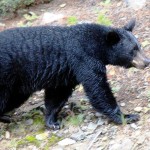Not Your Average Bear.
By Paul Stein
With the weather turning cooler and their food supply becoming naturally scarce, the black bears of Calaveras County are running short on days before they hibernate for winter. Many have been seen raiding campgrounds lately in the West Point and Arnold area. It won’t be long before Yogi and Boo-Boo forsake their perennial quest for picnic baskets and search for a cozy den to nap for the oncoming cold days of winter.
 American black bears feature prominently in folklore and mythology. They are revered by the Native Americans, symbolizing strength and endurance. The teddy bear was inspired by creator Morris Michtom when he came across a cartoon of President Theodore Roosevelt refusing to shoot a black bear cub trapped up a tree. Winnie the Pooh was named after Winnipeg, a female black bear cub that lived at the London Zoo from 1915 until her death in 1934. Probably the most iconic of black bears is Smokey the Bear—the mascot of the United States Forest Service, so named after a cub that was rescued at Lincoln National Forest in the spring of 1950.
American black bears feature prominently in folklore and mythology. They are revered by the Native Americans, symbolizing strength and endurance. The teddy bear was inspired by creator Morris Michtom when he came across a cartoon of President Theodore Roosevelt refusing to shoot a black bear cub trapped up a tree. Winnie the Pooh was named after Winnipeg, a female black bear cub that lived at the London Zoo from 1915 until her death in 1934. Probably the most iconic of black bears is Smokey the Bear—the mascot of the United States Forest Service, so named after a cub that was rescued at Lincoln National Forest in the spring of 1950.
A bear market on Wall Street connotes the downward trend of the stock market, and came from speculators in the sale of bearskins. Middlemen would sell skins they had yet to receive. As such, they would speculate on the future purchase price of these skins from the trappers, hoping they would drop. These middlemen became known as “bears,” short for bearskin jobbers, and the term stuck for describing a downturn in the market. Conversely, because bears and bulls were widely considered to be opposites due to the once-popular blood sport of bull-and-bear fights, the term bull market signifies a rising market.
The American black bear (Ursus americanus) is a medium-sized bear native to North America. It is the continent’s smallest and most widely distributed bear species, estimated to be twice that of all other bear species combined. Black bears are omnivores, their diets varying greatly depending on season and location. They typically live in large forested areas between 2500 and 6500 ft, but will leave forests in search of food.
Historically, black bears occupied the majority of North America’s forest regions. Today, they are primarily limited to sparsely settled forests, but the total population seems to have increased during the last decade. The overall population of black bears in the United States has been estimated to range between 339,000 and 465,000.
The average lifespan of black bears in the wild is 18 years, though it is quite possible for wild specimens to survive for more than 20 years. Known predators of bear cubs include bobcats, coyotes, cougars, wolves and brown bears. Currently American black bear fatalities are overwhelmingly attributed to human activities. Tens of thousands of black bears are hunted legally across North America, with many more being illegally poached or trapped.
Undoubtedly the most fascinating characteristic of black bears is their ability to hibernate—a state of inactivity in warm blooded animals characterized by low body temperature, slow breathing and heart rate, and low metabolic rate. Black bears enter their dens in October and November, but prior to that time, they put on up to 30 pounds of body fat to get them through the seven months during which they fast. During hibernation their heart rate drops from 40–50 beats per minute to 8 beats per minute and a special hormone (leptin) is released that stimulates the brain to suppress appetite. They hibernate in hollowed-out dens in tree cavities, under logs or rocks, in banks, caves, or culverts, and in shallow depressions. Although naturally-made dens are occasionally used, most dens are dug out by the bear itself. If the winter is mild enough, they may wake up and forage for food. Females give birth in February and nurture their cubs until the snow melts. During winter, black bears lose 25–40% of their body weight.
Black bears are opportunistic eaters. Most of their diet consists of grasses, roots, berries, and insects. Black bears that live in northern coastal regions (especially the Pacific coast) will fish for salmon during the night, as their black fur is easily spotted by salmon in the daytime. Other fish including suckers, trout, and catfish are caught when possible. They will also eat carrion, and easily develop a taste for human food and garbage. Bears that become habituated to human food at campsites, cabins, or rural homes can become dangerous and must be trapped and relocated, or killed—thus the frequent reminder: Please don’t feed the bears!
Black bears are also fond of honey, and will gnaw through trees if hives are too deeply set into the trunks to reach with their paws. Once the hive is breached, black bears will scrape the honeycombs together with their paws and eat them, regardless of bee stings.
Although an adult bear is quite capable of killing a human, American black bears typically avoid confronting humans. Unlike grizzly bears, which became a subject of fearsome legend among the European settlers of North America, black bears were rarely considered overly dangerous, even though they lived in areas where pioneers had settled. Black bear confrontations with humans are usually limited to mock charges, emitting blowing noises and swatting the ground with their forepaws.
Historically, black bears were hunted by both Native Americans and European settlers. Theodore Roosevelt wrote extensively on black bear hunting in which he stated “in [a black bear] chase there is much excitement, and occasionally a slight spice of danger, just enough to render it attractive; so it has always been eagerly followed“. Black bear meat had historically been held in high esteem among North America’s indigenous people and colonists. Roosevelt likened the flesh of young black bears to that of pork, and not as coarse or flavorless as the meat of grizzlies.
If you live in an area of Calaveras County frequented by black bears, know for certain that the time is drawing nigh when they will hibernate. But before they do, keep a watchful eye for any unattended picnic baskets or they are sure to disappear. Don’t feed the bears!
Paul Stein is a biologist with a long career in aquaculture. He was formerly chief deputy director of the California Department of Fish & Wildlife. He can be reached at [email protected]



